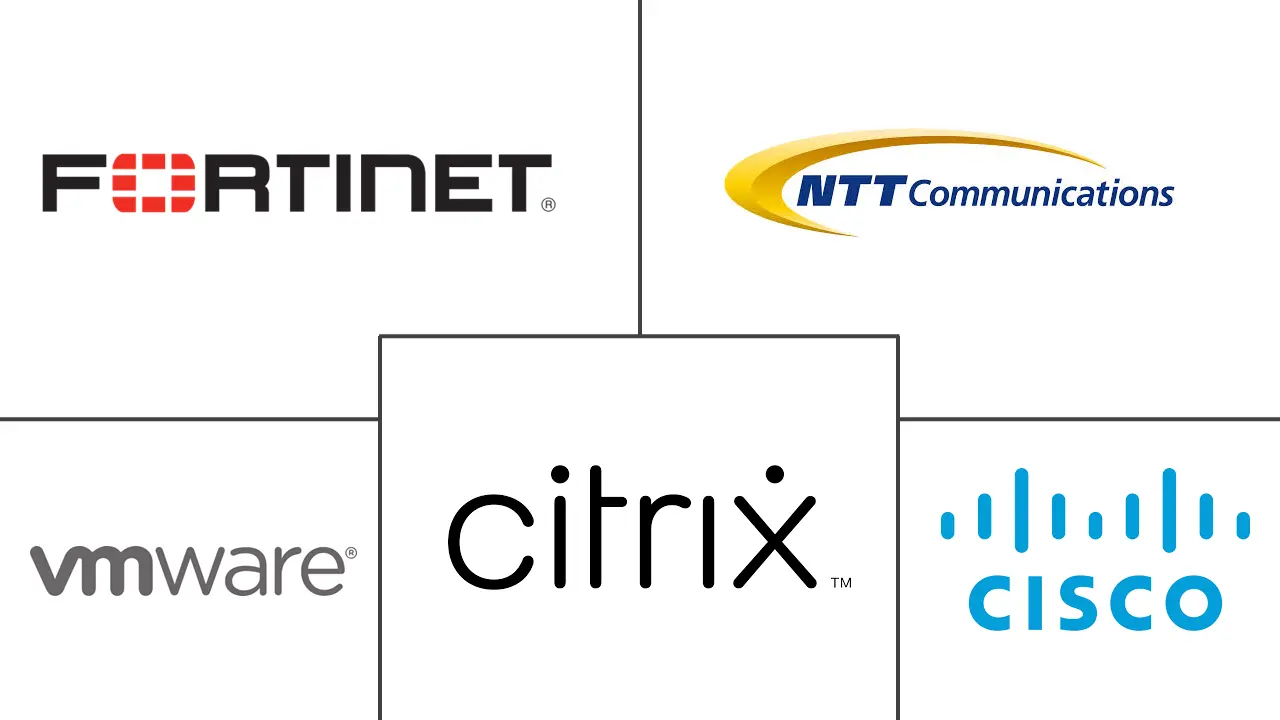WAN Optimization Market Size and Share
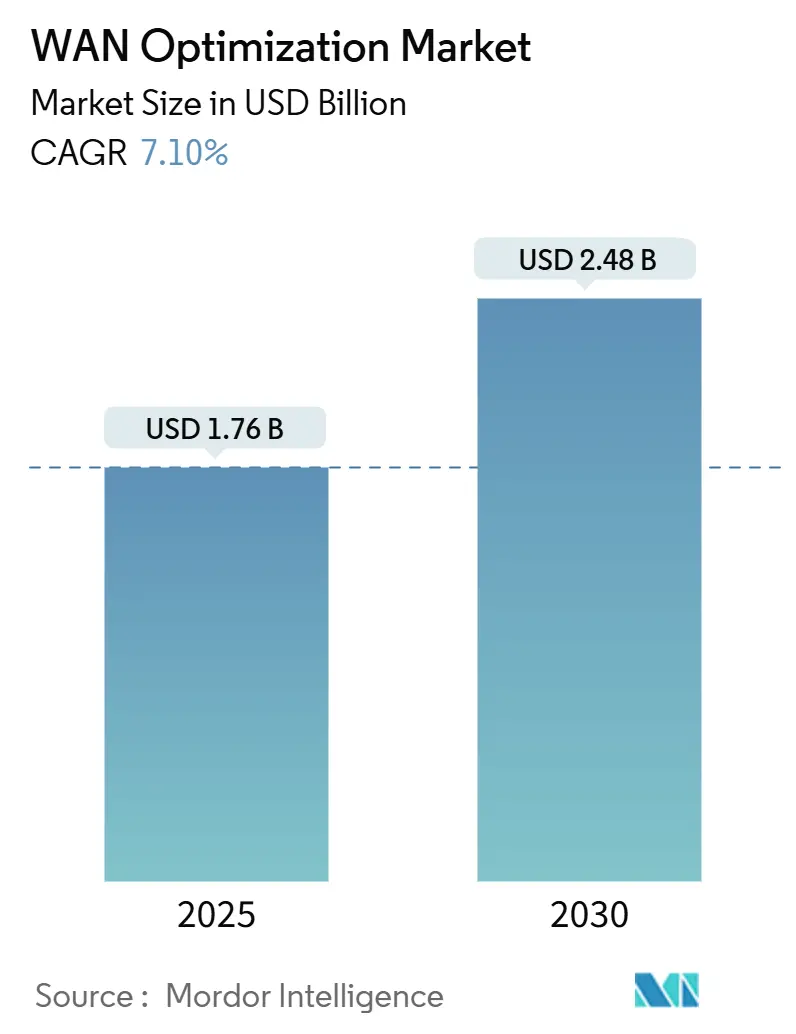
WAN Optimization Market Analysis by Mordor Intelligence
The WAN Optimization Market size is estimated at USD 1.76 billion in 2025, and is expected to reach USD 2.48 billion by 2030, at a CAGR of 7.10% during the forecast period (2025-2030).
Continued adoption of generative-AI workloads is reshaping enterprise traffic patterns, creating upload-heavy, latency-sensitive flows that legacy architectures cannot accommodate. Semiconductor supply-chain normalization in early 2025 supports renewed hardware roll-outs, while lingering geopolitical tension still influences component pricing. Enterprises favor dedicated appliances for deterministic performance, yet service-based optimization grows fastest as organizations outsource complex tuning task. Convergence with SD-WAN and SASE platforms signals the market’s shift toward unified networking-security frameworks, particularly for workloads that span edge, cloud, and satellite domains.
Key Report Takeaways
- By component, hardware appliances led with 46% of WAN optimization market share in 2024, while services are set to grow at a 17.2% CAGR through 2030.
- By solution type, SD-WAN–integrated offerings held 63% revenue share in 2024; SASE-embedded optimization is projected to expand at 24.5% CAGR to 2030.
- By deployment model, on-premises accounted for 58% share of the WAN optimization market size in 2024; cloud and virtual deployments will rise at 22.0% CAGR through 2030.
- By enterprise size, large organizations commanded 65% revenue in 2024, while SMEs recorded the strongest forecast CAGR at 19.5% through 2030.
- By end-user, BFSI held 24% revenue share in 2024, and healthcare is advancing at an 18.1% CAGR to 2030.
- By region, North America captured 33% of the WAN optimization market size in 2024; Asia Pacific is the fastest-growing geography at 7.01% CAGR.
Global WAN Optimization Market Trends and Insights
Drivers Impact Analysis
| Driver | ( ~ ) % Impact on CAGR Forecast | Geographic Relevance | Impact Timeline |
|---|---|---|---|
| Surge in cloud-centric application traffic | 1.80% | Global (APAC, North America) | Medium term (2-4 years) |
| Generative-AI workloads are exploding edge bandwidth | 2.10% | North America, EU, China, Japan | Medium term (2-4 years) |
| Industry 4.0 edge compute backhaul requirements | 0.90% | Manufacturing regions: Germany, China, Japan, the US | Long term (≥ 4 years) |
| LEO-satellite links needing optimization overlays | 0.50% | Remote regions globally, the Arctic, maritime | Long term (≥ 4 years) |
| Source: Mordor Intelligence | |||
Surge in Cloud-Centric Application Traffic Drives Optimization Demand
Accelerated migration to multi-cloud environments forces enterprises to manage unpredictable east-west traffic and direct-to-cloud routes. Cisco booked USD 350 million in AI infrastructure orders during Q2 2025, underscoring urgent demand for dynamically optimized connectivity. Hitachi and NTT Communications synchronized data across 600 km with sub-20 ms latency, illustrating how real-time replication relies on high-performance WAN overlays[1]Hitachi Ltd., “600 km Real-Time Data Sync Achieved via APN,” hitachi.com. Edge-cloud convergence amplifies the need for traffic steering that legacy hub-and-spoke designs cannot deliver. As organizations modernize disaster-recovery and analytics pipelines, optimization overlays become indispensable for cost-efficient bandwidth utilization. Consequently, the WAN optimization market continues to benefit from cloud traffic growth.
Generative-AI Workloads Exploding Edge Bandwidth Requirements
Large language models produce bursty, upload-heavy flows averaging 7,593 bytes per prompt, which strain static QoS schemes. Samsung’s patent for AI-aware traffic handling in 5G/6G networks confirms that conventional scheduling algorithms are insufficient. Broadcom’s VeloRAIN applies AI-driven detection to re-prioritize traffic in real time, ensuring generative-AI packets receive appropriate bandwidth without degrading legacy application performance. Meta’s low-latency path-failover patents show broader industry investment in AI-optimized routing. These innovations push the WAN optimization market toward adaptive, intelligence-first architectures.
Industry 4.0 Edge Compute Back-Haul Requirements Intensify
Eaton gained 10-15% OEE improvements by pairing PTC Factory Insights with optimized industrial WANs, cutting unplanned maintenance by 12%. Private-5G plants now deliver 480 Mbps with 10-14 ms latency, yet still require WAN acceleration for analytics backhaul. Foxconn’s rollout of 2,500 VDI instances across six factories underscores scale demands on link-optimization stacks. Lanner’s rugged SD-WAN gateways aggregate 4G/5G, satellite, and MPLS to maintain uptime on factory floors. Consequently, manufacturing digitalization keeps fueling the WAN optimization market.
LEO-Satellite Links Requiring Optimization Overlays
Skylo’s SatPlus eSIM blends cellular and satellite paths, letting policies redirect traffic based on latency or cost. Druid Software and Skylo extend Non-Terrestrial Network (NTN) services to Industry 4.0 sites, providing redundancy for critical telemetry. Hybrid satellite-terrestrial architectures need compression, caching, and forward-error correction to offset link delay, reinforcing demand for WAN optimization market offerings. Meta’s 50,000 km Project Waterworth cable adds further diversity for global traffic engineering. As enterprises blend LEO links with undersea paths, optimization overlays ensure a consistent user experience.
Restraints Impact Analysis
| Restraint | ( ~ ) % Impact on CAGR Forecast | Geographic Relevance | Impact Timeline |
|---|---|---|---|
| High CAPEX & lifecycle maintenance cost | -1.40% | Global, especially SMEs | Short term (≤ 2 years) |
| Convergence into SASE diluting the stand-alone demand | -1.10% | Global enterprises | Medium term (2-4 years) |
| Source: Mordor Intelligence | |||
High CAPEX and Lifecycle Maintenance Costs Constrain Adoption
Component shortages linked to AI server demand raised hardware prices, elevating the total cost of ownership for dedicated appliances. Broadcom’s post-acquisition pricing shifts for VMware reportedly exceeded 400% in some bundles, forcing buyers to reassess on-premises spend. Subscription licenses mitigate upfront cost but can raise multi-year OPEX, challenging SME budgets. Hardware redesigns to meet EU standby-power caps (< 0.5 W) add further cost pressure[3]Nemko AS, “EU Regulation 2023/826 Standby Power Limits,” nemko.com. Collectively, these factors moderate near-term growth in the WAN optimization market.
Convergence into SASE Diluting Stand-Alone Demand
Aryaka’s “Unified SASE as a Service” bundles CASB and optimization, reflecting buyer preference for single-vendor stacks. GigaOm scores SASE adoption at 4.6/5, signaling mainstream shift to converged architectures. Cloud-native SASE lets hyperscalers embed acceleration at POPs, reducing the need for customer-premises devices. As optimization becomes a checklist feature inside larger security contracts, stand-alone vendors face margin pressure. The WAN optimization market, therefore, tilts toward integrated delivery models even as total addressable demand grows.
Segment Analysis
By Component: Services Accelerate Despite Hardware Dominance
Hardware appliances maintained 46% revenue in 2024, reflecting enterprises’ desire for deterministic throughput and packet inspection at wire-speed, with 10 Gbps benchmarks recorded on VMware edge devices. Hardware’s share translates to 46% of the WAN optimization market size for that year. At the same time, service-based offerings are posting a 17.2% CAGR through 2030 as organizations outsource configuration and policy tuning to specialist providers. Energy-efficient designs, such as Cisco’s Catalyst switches carrying ENERGY STAR labeling, help hardware retain relevance by lowering operational costs.
Managed and professional services capitalize on rising algorithmic complexity that demands constant policy adaptation. Vendors bundle monitoring, AI-assisted anomaly detection, and lifecycle support, reducing enterprises’ skills burden. Consequently, services reinforce recurring revenue streams and diversify the WAN optimization market beyond product sales.
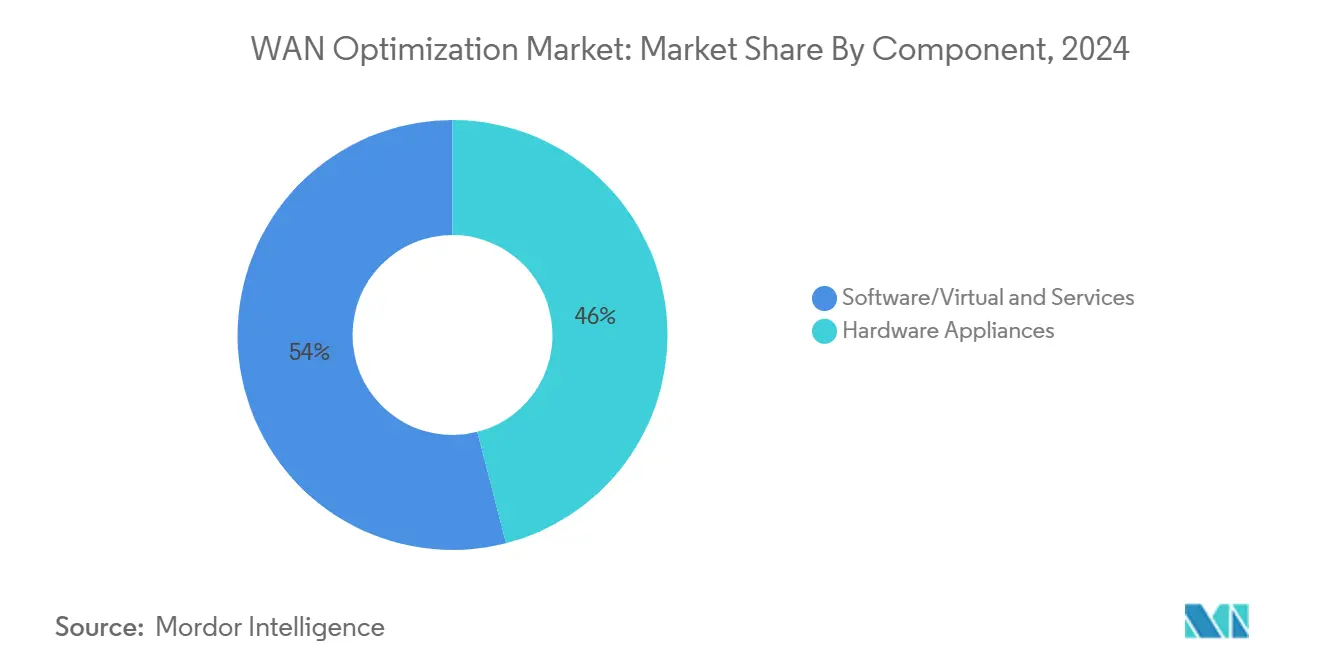
Note: Segment shares of all individual segments available upon report purchase
By Solution Type: SASE Integration Accelerates Market Evolution
SD-WAN–integrated products captured 63% revenue in 2024, thanks to widespread refresh cycles that replaced MPLS and router stacks with software-defined fabrics. SASE-embedded optimization, although smaller today, is advancing at a 24.5% CAGR, riding enterprise appetite for unified threat prevention and performance management. Broadcom’s VeloRAIN shows how AI-native detection links optimization with zero-trust segmentation, broadening addressable use cases.
Demand acceleration reflects the prediction that 85% of enterprise workloads will operate in the cloud by 2025, compelling firms to centralize control over identity, security, and traffic engineering in one policy engine. As a result, the WAN optimization market is converging toward platform-based consumption models that fold acceleration into holistic service edge frameworks.
By Deployment Model: Cloud Transformation Drives Hybrid Adoption
On-premises deployments still account for 58% of revenue because regulated industries require full control over packet paths and data residency. That slice equates to 58% of the WAN optimization market size in 2024. Cloud and virtual form factors, however, record a 22.0% CAGR as enterprises pursue elastic scaling, pay-as-you-use pricing, and zero-touch upgrades. Hybrid topologies combine the two, preserving local processing for sensitive flows while redirecting generic traffic through cloud POPs.
A10 Networks’ 9% revenue rise in Q1 2025 reflects the uptake of appliance-agnostic software that can run on bare metal, virtual machines, or public-cloud instances. Extreme Networks’ Platform One brings AI-assisted troubleshooting across any deployment, illustrating how tools span physical and virtual estates to unify policy management. These launches validate hybrid as the dominant model for the WAN optimization market.
By Enterprise Size: SME Adoption Accelerates Through Cloud Models
Large enterprises held 65% revenue in 2024, leveraging multitenant controllers to orchestrate thousands of sites. SMEs, though smaller in spend, are on a 19.5% CAGR trajectory as cloud-native delivery removes traditional up-front appliance cost. Airtel Business cut a major bank’s network expenditure by 40% after shifting to managed SD-WAN, showcasing ROI that resonates with mid-market buyers.
SMEs frequently choose subscription bundles that merge connectivity, security, and optimization in one portal, minimizing in-house expertise requirements. This democratization broadens the WAN optimization industry’s customer base and stabilizes long-term growth.
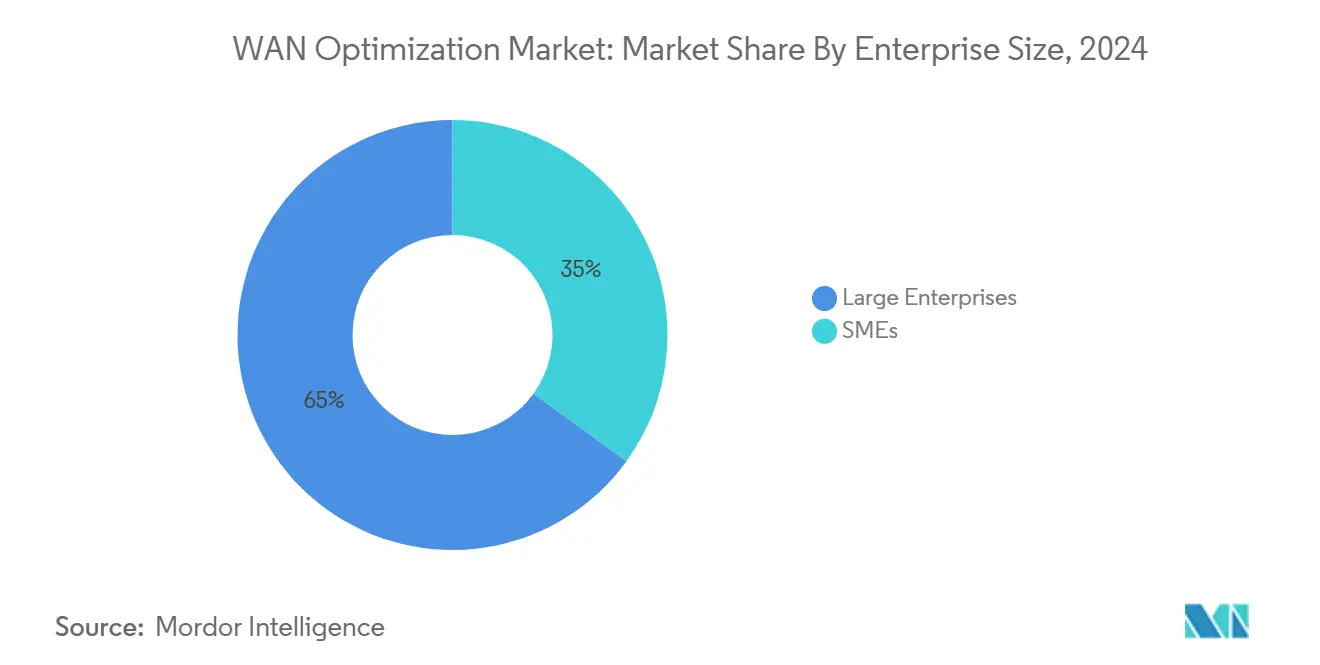
Note: Segment shares of all individual segments available upon report purchase
By End-User Industry: Healthcare Leads Growth Amid BFSI Dominance
BFSI kept a 24% revenue share in 2024 thanks to low-latency trading and stringent compliance that mandates deterministic packet delivery. Healthcare, however, posts the fastest 18.1% CAGR through 2030 as telemedicine and IoT diagnostics multiply bandwidth demand. Hospital systems such as Novant Health rely on fabric-based core networks to support more than 1 Gbps links for EMR and imaging workloads.
Regulatory push for data sovereignty and cybersecurity further compels hospitals to deploy optimization plus encryption in tandem. Manufacturing, IT-telecom, and energy also extend adoption as Industry 4.0 and remote asset monitoring scale. Together, these verticals diversify end-market exposure for the WAN optimization market.
Geography Analysis
North America captured 33% of the WAN optimization market share in 2024, underpinned by robust enterprise IT budgets and secure-connectivity mandates. Federal sustainable-procurement rules spur demand for low-power hardware, while AI innovation grants intensify network upgrades[4]Federal Register, “Sustainable Procurement Amendment,” federalregister.gov. Cisco’s USD 13.99 billion Q2 2025 revenue underscores continuing infrastructure investment, much of it earmarked for AI-ready Ethernet fabrics. Regional buyers emphasize zero-trust and observability, steering vendors toward SASE convergence.
Asia Pacific is the fastest-growing geography at 7.01% CAGR. Japan alone expects telecommunications equipment spend to reach 4.362 trillion yen (USD 29.1 billion) by 2026, reflecting aggressive 5G/6G and data center builds[2]Communications and Information Network Association of Japan, “Japan Telecom Equipment Forecast 2026,” ciaj.or.jp. Sovereign-cloud mandates across India, Indonesia, and Australia necessitate localized acceleration nodes to comply with data-residency laws. Vendors like Huawei and Palo Alto Networks expand local POPs, improving service latency and fueling regional WAN optimization market momentum.
Europe maintains a substantial slice of the WAN optimization market size due to strict energy directives. EU Regulation 2023/826 caps standby power at 0.5 W, compelling vendors to incorporate advanced power management. The proposed Digital Networks Act seeks to harden connectivity resilience, indirectly encouraging greater traffic-optimization investment. Meanwhile, subsea-cable security initiatives increase demand for encryption and optimization overlays to secure transboundary flows. Emerging regions such as Latin America and Africa register modest growth as infrastructure funding accelerates, opening long-run potential for cloud-managed optimization services.
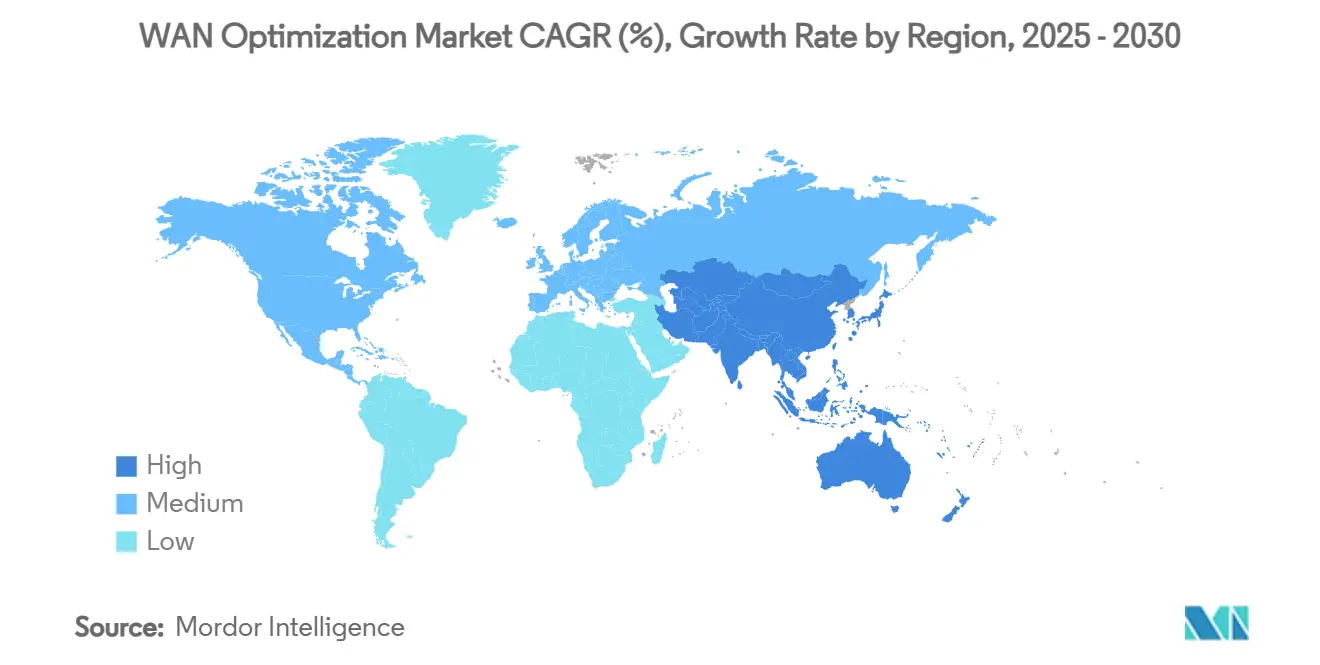
Competitive Landscape
The WAN optimization market shows moderate concentration with traditional networking majors, niche accelerators, and SASE specialists vying for share. Cisco’s USD 28 billion Splunk acquisition folds observability with networking, granting deeper packet-to-app analytics and raising entry barriers for smaller rivals. HPE’s pending USD 14 billion Juniper purchase, still under regulatory review, could compress the standalone vendor pool and bundle optimization inside AI-cloud offerings.
Strategic activity centers on AI-aware traffic handling, energy efficiency, and vertical integration. Cisco’s joint work with NVIDIA on Spectrum-X ASICs targets Ethernet-based AI fabrics, while Broadcom’s VeloRAIN introduces static-to-adaptive rule conversion at the edge. White-space innovation persists in satellite-link optimization and healthcare-specific policies. Nonetheless, vendors lacking security or AI toolsets face acquisition or niche retreat as buyers prefer consolidated stacks. Channel alliances with global ISPs, cloud providers, and systems integrators serve as critical scale multipliers in the competitive race.
WAN Optimization Industry Leaders
-
Cisco Systems Inc.
-
NTT Communications
-
Citrix Systems, Inc.
-
VMware LLC
-
Fortinet Inc.
- *Disclaimer: Major Players sorted in no particular order
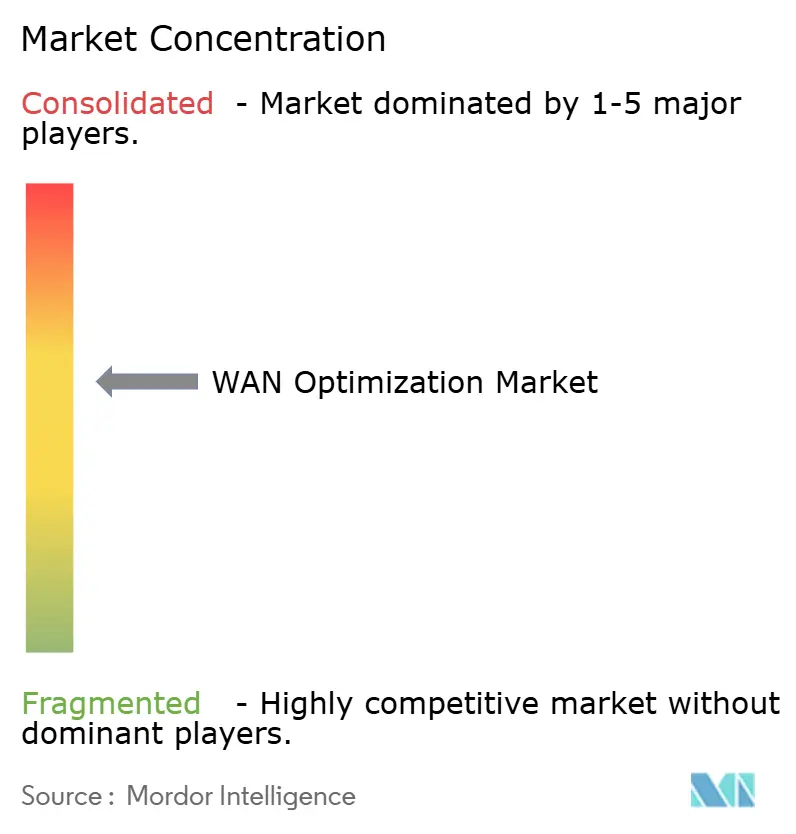


Recent Industry Developments
- February 2025: Broadcom introduced VeloSky, a converged networking platform for communications-service providers, integrating fiber, cellular, and satellite with dynamic multipath optimization.
- January 2025: TerreStar Solutions and Skylo Technologies partnered to extend direct-to-device satellite services across Canada, enhancing coverage for remote enterprises.
- December 2024: Hitachi and NTT Communications achieved real-time 600 km data synchronization with less than 20 ms round-trip latency using IOWN All-Photonics Network and storage virtualization.
- November 2024: Broadcom unveiled VeloRAIN architecture, combining AI-driven application detection with high-throughput Edge 4100/5100 appliances.
Research Methodology Framework and Report Scope
Market Definitions and Key Coverage
We at Mordor Intelligence define the wide-area-network (WAN) optimization market as all vendor revenue from hardware appliances, virtual instances, and cloud-delivered services whose specific role is to boost throughput, trim latency, and compress or deduplicate traffic that crosses enterprise WAN links.
For clarity, we exclude stand-alone SD-WAN orchestrators and generic layer-4 load balancers that lack dedicated acceleration engines.
Segmentation Overview
- By Component
- Hardware Appliances
- Software/Virtual
- Services
- By Solution Type
- Traditional WAN Optimizers
- SD-WAN Integrated
- SASE-embedded Optimization
- By Deployment Model
- On-premises
- Cloud/Virtual
- Hybrid
- By Enterprise Size
- SMEs
- Large Enterprises
- By End-User Industry
- BFSI
- Healthcare and Life Sciences
- Retail and eCommerce
- Manufacturing and Industrial
- IT and Telecom
- Government and Public Sector
- By Geography
- North America
- United States
- Canada
- Mexico
- South America
- Brazil
- Rest of South America
- Europe
- Germany
- United Kingdom
- France
- Russia
- Rest of Europe
- Asia-Pacific
- China
- India
- Japan
- South Korea
- ASEAN
- Rest of Asia-Pacific
- Middle East
- Saudi Arabia
- UAE
- Turkey
- Rest of Middle East
- Africa
- South Africa
- Rest of Africa
- North America
Detailed Research Methodology and Data Validation
Primary Research
We interview network architects, managed-service providers, and branch IT managers across North America, Europe, and Asia-Pacific to validate adoption triggers, average selling prices, and refresh intervals. Short online surveys let us confirm penetration rates that secondary literature only hints at.
Desk Research
Our analysts begin with authoritative public datasets such as International Telecommunication Union bandwidth statistics, US FCC enterprise-broadband records, Eurostat ICT usage surveys, and UN Comtrade codes that map to optimization gear. We then tap D&B Hoovers for company financials, Dow Jones Factiva for deal news, Questel for patent clusters, and trade bodies like the Open Networking Foundation to refine technology lifecycles. These sources anchor baseline figures, while many other open repositories subtly enrich the evidence pool.
Market-Sizing & Forecasting
We model the market top-down, translating the global count of enterprise sites and average spend per optimized link into a demand pool, which we cross-check with sampled vendor revenue roll-ups and channel ASP × volume snapshots. Key drivers we track include branch-count expansion, cloud workload share, MPLS-to-internet migration speed, appliance replacement cycles, and price erosion on 1 Gbps platforms. Forecasts through 2030 flow from multivariate regression that links revenue to GDP-weighted IT spend and WAN-traffic growth scenarios vetted by our experts. Where bottom-up evidence is thin, we apply gap factors transparently before triangulation.
Data Validation & Update Cycle
Our outputs face multi-layer variance checks against shipment trackers and deal-flow signals. Senior analysts review anomalies, and reports refresh annually, with interim updates triggered by large vendor moves or technology inflections so clients always receive the latest view.
Why Mordor's WAN Optimization Baseline Commands Reliability
We recognize that published estimates often diverge; differing scopes, price assumptions, and refresh cadences drive the gaps.
Key gap drivers include whether SD-WAN-embedded optimization revenue is counted, the treatment of subscription renewals, and the rigor of price-erosion adjustments that our team revisits each year.
Benchmark comparison
| Market Size | Anonymized source | Primary gap driver |
|---|---|---|
| USD 1.76 B (2025) | Mordor Intelligence | |
| USD 1.40 B (2025) | Global Consultancy A | Excludes cloud-delivered acceleration modules and uses static ASPs |
| USD 3.94 B (2025) | Regional Consultancy B | Applies shipment uplift without stripping multi-year support bundles |
| USD 4.68 B (2025) | Industry Journal C | Counts broader network-optimization services and relies on older FX rates |
The comparison shows that when scope creep and outdated price tables are removed, Mordor's disciplined, annually refreshed approach offers a balanced, transparent baseline that decision-makers can trust.


Key Questions Answered in the Report
What is the current value of the WAN optimization market?
The WAN optimization market stands at USD 1.76 billion in 2025 and is on track to hit USD 2.48 billion by 2030.
Which component segment is growing fastest?
Managed and professional services are expanding at a 17.2% CAGR because enterprises increasingly outsource complex optimization tasks.
Why is Asia Pacific the fastest-growing region?
Large-scale 5G, cloud, and data-center investments, such as Japan’s projected USD 29.1 billion telecom spend by 2026, drive accelerated adoption of optimization platforms.
How are generative-AI workloads influencing WAN optimization strategies?
AI applications create bursty, upload-heavy traffic that requires adaptive bandwidth allocation and AI-driven policy engines, prompting vendors to add intelligence to optimization stacks.
What role does SASE play in the WAN optimization landscape?
SASE integration embeds optimization alongside security functions, reducing stand-alone appliance demand and shifting purchase decisions toward unified service-edge platforms.
Are energy regulations affecting hardware choices?
Yes. EU Regulation 2023/826 mandates less than 0.5 W standby power, pushing vendors to adopt advanced power-management ASICs and helping buyers select certified, energy-efficient devices.
Page last updated on:
